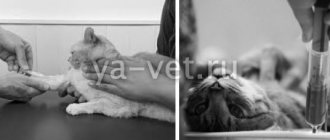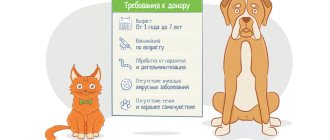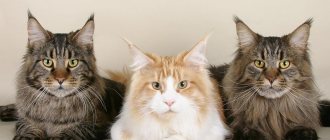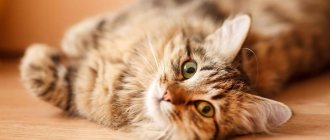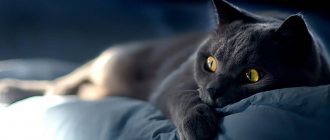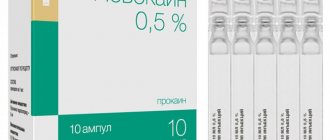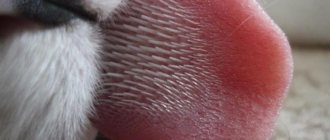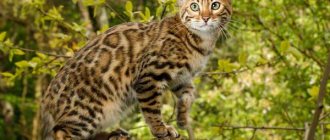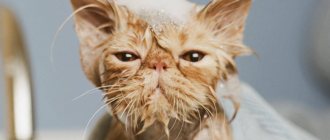Causes
One of the main reasons for an increase in the enzyme is diseases such as cholestasis and cholangitis. Pathologies are characterized by a decrease in the volume of bile produced.
ATTENTION! In practice, it is quite difficult to use the values of ALP in the biochemical composition of blood to determine diseases, since the latter decomposes quite quickly, within a few hours.
The second reason is long-term use of corticosteroid drugs during rehabilitation after surgery. Kittens are characterized by an increase in alkaline phosphatase during the period of strengthening bone tissue. In older cats, the level of the enzyme changes depending on the orthopedic diseases they have suffered.
The isoenzyme that regulates the activity of alkaline phosphatase is produced in the small intestine. But, in general, its activity has not been sufficiently studied, so changes in the enzyme level alone cannot be used. A comprehensive analysis of all blood components is required.
Let us note the main diseases of the gastrointestinal tract that provoke an increase in alkaline phosphatase:
- Cirrhosis and necrosis of the liver.
- Hepatitis.
- Infectious poisoning.
Enzyme activity provokes cancer and tuberculosis. ALP levels in cats are affected by taking certain antibiotics, vitamin C, and kidney problems.
For cats during pregnancy, changes in enzyme levels are normal and should not cause concern. Alkaline phosphatase is involved in the formation of the fetus and placenta.
Activity increases in the last weeks of pregnancy (3rd trimester).
Significance of changes in the de Ritis coefficient
The de Ritis ratio is the ratio of AST and ALT. For a cat, the norm is 1.3 (error in both directions is 0.4). For chronic liver diseases, the coefficient varies from 1 to 1.3. If it falls below one, it means that the disease is acute. At the same time, the level of ALT increases.
The de Ritis coefficient in cats is an indicator indicating cardiac or liver pathologies
An increase in the coefficient above 1.3 indicates diseases of the heart muscle, incl. myocardial infarction. This indicator is also characteristic of liver damage from toxins.
Also, with the help of such a study, it is possible to evaluate the functioning of the animal’s internal organs, reaction to a new diet, etc. During treatment, biochemistry is performed several times to see how effective the prescribed therapy is.
Cholestasis
The disease is characterized by disruption of the liver and gallbladder. At the first stage, bile ceases to be excreted into the duodenum.
Of course, not immediately, but every day more and more secretions remain in the gallbladder. Stagnation of bile occurs and it is gradually absorbed into the blood. Internal intoxication of the body occurs. Cholemia develops, which is fraught with the most tragic consequences for the cat. Let us note the main symptoms that will help owners identify impending cholestasis:
- Partial or complete refusal to eat, the animal does not even touch its favorite treats.
- The animal sleeps more often and avoids contact with family members.
- The mucous membranes turn yellow;
- Urine acquires a sharp, unpleasant odor and becomes significantly darker.
- Vomit.
- The feces are mostly liquid, with a white coating, mostly light in color.
- Kidney failure develops.
The veterinarian chooses the treatment independently. It depends on the cause of the disease. Benign tumors that can form during stagnation are removed surgically .
Pathogenic microorganisms are destroyed by antibiotics. Drugs are often used in parallel to thin the bile.
What to do if alkaline phosphatase is elevated?
Proper treatment and care for the animal will help get rid of the disease.
It is clear that when a disease occurs, it must be treated. After undergoing a clinical examination and identifying pathology in your pet, you need to find out more information about this disease and learn how to properly care for the animal during treatment.
Cholestasis
The animal needs immediate care and treatment. The consequences may be irreversible!
A disease associated with dysfunction of the liver and gallbladder is cholestasis.
The mechanism for the appearance of pathology is the impossibility of removing bile into the lumen of the duodenum, as a result of which it stagnates in the bladder itself and its pathways and is subsequently absorbed into the blood, thereby giving rise to a difficult process - cholemia . As a result of severe toxicity of bile, severe poisoning of the entire body occurs. If action is not taken immediately, the cat will die.
Symptoms
Externally, a sick cat does not differ from its healthy counterparts.
The signs of this disease are very extensive and contradictory, due to the variety of causes of its occurrence.
- The cat may be overly sleepy, refuse to eat, or, conversely, experience insatiability.
Excessive sleepiness of the pet should alert the owner.
A cat's weight loss can also be an alarming symptom!
Treatment
Treatment depends on the causes of the disease.
- Neoplasms and echinococcal blisters are eliminated surgically.
Hyperparathyroidism
Problems arise when the thyroid gland begins to produce too much hormone. An imbalance is created in the body, the functioning of many organs is disrupted. Among the main reasons, experts note feeding with cheap food, fried, spicy and any food from the human table. Oddly enough, excessive consumption of fish will also lead to hyperparathyroidism.
ATTENTION! For prevention purposes, it is worth balancing your cat’s diet. Eliminate foods rich in phosphorus as much as possible and add foods high in calcium (eggs or a little milk) to your diet.
Other reasons include a genetic predisposition to calcium absorption disorders or an overly active kitten's mouth. For diagnostic purposes, the radiography method is used . A comprehensive blood and urine test is performed. As you know, a lack of calcium leads to problems with bone tissue. For better results, the entire animal is examined.
The test results show areas where bone tissue is difficult to distinguish from muscle tissue. X-rays can help identify areas where bones have become thinner and their overall density has been reduced.
External signs include:
- low mobility;
- unsteadiness of gait;
- frequent problems with bone fractures.
As mentioned above, it is difficult to judge problems only by deviations of alkaline phosphatase in one direction or another. Additional information about bilirubin and gamma-glutamine stransferase levels is often required. Judging by the norm of the enzyme, its indicators range from 39 to 55 units.
Prevention and treatment
Many owners who are faced with the problem of enzyme production are interested in under what circumstances should the level of SF be examined in a biochemical blood test? Changing enzyme levels act as a litmus test for the following diseases:
- kidney and bone cancer;
- problems with the liver and biliary tract;
- osteodystrophy;
- metastases in bone tissue.
During the analysis, it is imperative to warn the veterinarian about the medications that the pet has taken. The analysis results are distorted when exposed to large doses of ascorbic acid, interferon, non-steroidal anti-inflammatory drugs, levamisole, penicillin and a number of other drugs. In any case, it is useful to check the list with your veterinarian.
As with most tests, blood is drawn from a vein on an empty stomach. A competent specialist checks the level of alkaline phosphatase throughout the course of treatment in order to respond in time to possible deviations.
IMPORTANT! During the rehabilitation period at home, a proper diet is important. In most cases, experts recommend specialized foods.
In case of obvious fractures, the pet's mobility should be limited. Give the cat a new home in a carrier or specially organize a place in the apartment for this. In extreme cases, a regular box with high sides will do.
The main thing is to ensure a comfortable temperature in the apartment, quick access to water and food. The average period of forced isolation is about 2 months. Much depends on the level of alkaline phosphatase and other enzymes. In extreme cases, droppers or intravenous injections of calcium solution are possible.
the cat has chronic renal failure and a highly elevated alkaline phosphatase level
Rostov region. The cat is 17 years old. Weight 2.6 kg. 12 years ago my uterus was removed. He sits at home, sometimes goes out into the yard for a walk. No vaccinations were given. I give it regularly for worms. Almost all my life I ate domestic canned food like “Night Hunter”, as well as canned food “Whiskas”. Two years ago I switched to Royal dry food for sensitive digestion. About a year ago, vomiting appeared - 30-40 minutes after eating, but not every day. I thought it was from the wool. I started giving Maltpaste regularly. Did not help. The pharmacy recommended Mezim (the cat is old - there are not enough enzymes). Got better. After some time, she appeared again. vomit. Moved to Hills. Instead of Mezim I gave Pancreatin and the vomiting stopped. In 2011 I had cystitis. We successfully treated him. Since February 23, the cat did not pee for 2 days, but she was feeling as usual: she ate and drank water. The temperature was 38 degrees. On the third day, she urinated. I collected urine and went to the doctor. The clinic did biochemistry and ultrasound. A general blood test was apparently considered unnecessary. Gamavit, Kantaren and KotErwin were prescribed. The ultrasound did not find any stones or sand. Here are the test results. Biochemical blood test 02.25.14. Indicator Unit change Normal Result Total protein g/l (57-80) - 70.7 Albumin g/l (24-38) - 23.4 Glucose Mol/l (3.4-6.9) - 6.69 α-Amylase Units ./l (371-1193) - 1889.5 Bilirubin µmol/l (1.2-7.9) - 10.5 Alkaline Phosphatase U./l (12-65) - 114.5 AlAt U./l ( 8.3-53) - 261.9 AsAt U/l (9.2-40) - 216.9 Creatinine µmol/l (49-165) - 249.1 Urea mmol/l (5.5-11, 1) — 12.34 General urine analysis Indicator Unit. change Norm Result quantity ml (-) - 120 Color (Yellow) - Yellow transparency - (Full) - Not complete Density - (1.015-1.060) - 1.025 pH kg/m3 (5.5-7.5) - 5.5 Ascorbic acid units (absent) - 15 Glucose mg/100 ml (absent) - Absent Nitrites mg/100 ml (absent) - Absent Protein presence (absent) - Absent Ketones mg/100 ml (absent) - Absent Urobilinogen mg/100 ml (0. 1-1.0) - 1.0 Bilirubin mg/100 ml (Absent) - 0.5 Leukocytes presence (1-3 in x) - 1-3 in x Red blood cells Presence (1-3 in x) - Absent Salts Presence ( - ) - Uric acid Renal epithelium Presence (Absent) - Absent Flat epithelium Presence (0-2 in x) - 0-4 in x Cylinders Presence (Absent) - Absent Bacteria Presence (Absent) - Cocci (+) rods (+ +) Mucus Presence (absent) - Absent Transitional epithelium (Units) - Absent Ultrasound 02/25/14 bladder - empty; Left kidney - uneven edges, size. – 2.58 by 2.06 cm, parenchyma 0.51 cm, heterogeneous structure, increased echogenicity, pelvis not dilated, no stones identified. Right kidney – uneven edges, size. – 2.93 by 1.98 cm, parenchyma – 0.46 cm, heterogeneous structure with increased echogenicity, the pelvis is not dilated, no stones were identified. Conclusion – structural changes in the renal parenchyma. After receiving such tests, they told me that everything was very bad and offered to put her to sleep and not torment her with treatment, because it was impossible to force the kidneys to work. I took tests and went to another doctor. Another doctor, upon palpation, discovered uneven contours of the kidneys and tubercles on the peritoneum. Due to increased alkaline phosphatase, she suggested oncology. According to the urine test, she suggested injecting ceftriaxone for 3 days, cantaren, gamavit, Essentiale and Creon capsules (1/4 cap x 3 rubles per day). She said that the cat is 90 years old by human standards and there is no need to torture her, but if you want, you can put IVs. The cat’s state of health practically did not change, she just lay more, but she met and saw me off from work, ate less than usual, but did not urinate and became constipated. After reading veterinary forums on the Internet, I decided to prescribe IVs for the cat myself, because she stopped drinking, although I gave her kidney herbs, but this was not enough. I went to the clinic again and asked for a cannula for IVs. There they considered it necessary to instill saline solution 70 ml, glucose 70 ml, Maniiit 15 ml, cytoflavin 10 ml. On the third dropper, I removed Cytoflavin and added Essentiale IV 1 ml. In addition to herbs, I also poured polysorb into my mouth. The cat's condition did not improve. She was bothered by the cannula and began to have trouble eating. She had no stool for 5 days. Therefore, after 5 days of droppers. I decided to remove the catheter and do repeated tests. The cat’s weight increased by 300 g (why?). At my request, they added calcium, phosphorus and potassium indicators and a sugar test to the biochemistry (they immediately said it was normal). Biochemical blood test 03/6/14 Indicator Unit. change Normal Result Total protein g/l (57-80) - 63 Albumin g/l (24-38) - 19.9 Glucose Mol/l (3.4-6.9) - 6.82 α-Amylase Unit/ l (371-1193) - 1579.6 Bilirubin µmol/l (1.2-7.9) - 15.6 Alkaline Phosphatase U./l (12-65) - 190 AlAt U./l (8.3- 53) - 389.5 AsAt Units/l (9.2-40) - 156.2 Creatinine µmol/l (49-165) - 173.5 Urea mmol/l (5.5-11.1) - 7 .58 Calcium mmol/l (2.0-2.7) - 3.37 Phosphorus mmol/l (1.3-2.4) - 1.26 Potassium µmol/l (3.6-5, - 7. 6 General blood test Red blood cells million/µl (6.6-9.4) - 6.64 Hematocrit % (24-45) - 31.4 Hemoglobin g/l (80-150) - 95 Leukocytes thousand/µl (5. 5-19.5) — 4.1 Basophils % (0-1) — — Myelocytes % (-) — — Young % (-) —- — Lymphocytes % (36-54) — 36 Monocytes % (1-5) — 0 Eosinophils % (2- — 4 Bands % (3-9) — 2 Segientonuclear % (40-45) — 58 Thrombocytes thousand/μl (300-800) — 61 General urine test 03/6/14 Protein is normal Sugar -norm Acetone-norm Urobilin-norm Leukocytes 0-1vx Bile pigments -norm Indican-norm Hyaline cylinders -2 Unchanged red blood cells -norm Granular cylinders-norm Waxy cylinders -norm Cylinders -norm Released red blood cells -norm Kidney epithelium -norm Transitional epithelium 0- 1vx According to the test results, it turns out that urea, creatinine, AST, AlAt, alpha-amylase decreased, but alkaline phosphatase increased. I continue Gamavit 2 ml, Kantaren 2 ml, Essentiale 13 capsules x 3 times a day, Liarsin 1 t. x 3 rubles, Renal advanced 2 scoops per day. The cat began to eat and drink better, but pees once a day. Please give me advice after how long to resume IV drips and what to do with the alkaline phosphatase level?
Blood chemistry
For the owner, it is important, if not to understand, then at least to navigate the abundance of enzymes and substances that will tell you about the current state of the animal. Of course, a detailed diagnosis will be carried out by a specialist, but an owner who cares about the health of the pet should show interest in the treatment process.
Let us note the main indicators that are taken into account in the blood test:
- Bilirubin. One of the main substances that make up bile. The substance is also involved in the coloring of blood. Its excess leads to changes in skin color and says a lot about liver disease (hepatitis) or problems with the bile ducts. Deficiency leads to bone marrow damage. The norm for an adult animal is 3-12 units.
- Urea. The external factor of many diseases is excessive urination, change in color and odor. An abundance of urea indicates blockage of the urinary tract and poor kidney function. But it is important to understand that excess discharge can be associated with diet. Problems arise when feeding foods rich in animal protein. The norm for an adult animal is 5-12 units.
- Glucose. Excess sugar in the body is the cause of a variety of diseases. For example, diabetes mellitus, the release of adrenaline into the blood during frequent, excessive exercise or stress. Experts also note problems with the kidneys, liver, and pancreas. Glucose levels drop during poisoning, prolonged fasting or excess alcohol. The norm for an adult animal is 3-6 units.
- Phosphorus. Increased levels are typical for animals with leukemia or bone tumors. Other causes include excess vitamin D and kidney failure. What is interesting is that long-term diarrhea leads to a decrease in phosphorus levels. The norm for an adult animal is 1-2.3 units.
- Calcium. The microelement increases due to severe dehydration, damage to bone tissue by cancer and excess vitamin D. Problems with kidneys, pancreatitis and vitamin D deficiency, calcium levels drop rapidly. The norm for an adult animal is 2-2.7 units.
- Total protein. Excessive vomiting and prolonged diarrhea contribute to increased levels of the substance. This also includes dehydration. A sharp decline in total protein is observed with intestinal diseases, cirrhosis, hepatitis, renal failure and prolonged fasting. The norm for an adult animal is 54-77 units.
As you can see, it is not only the indicators of alkaline phosphatase or amylase that you should pay attention to. Only a comprehensive analysis and competent processing of results will make it possible to prescribe an effective course of treatment.
About the cat. Chronicles chronicle
It's more for yourself. I will write here how things are going. Tests, feeding, behavior, etc. It’s more convenient for me - the chronology will be visible. The post will be constantly updated. 06.06.2014Biochemistry of blood. For some reason, there is no data on GGT and ALP (alkaline phosphatase).
| Normal for cats | Unit measurements | Result | |
| AST (GOT) | 10-80 | U/L | 21,5 |
| ALT (GPT) | 10-80 | U/L | 84,6 ↑ |
| BIL (general) bilirubin | 0.1-0.6 | MG/DL | 0,66 |
| CREA creatinine | 0.8-1.8 | MG/DL | 1,32 |
| UREA urea | 30-65 | MG/DL | 52,6 |
| AMYL amylase | 500-1800 | U/L | 2004 ↑ |
| GLU glucose | 70-150 | MG/DL | 66 ↓ |
AST/ALT ratio = 0.25 I read this:——-
https://siberians.forum24.
ru/?1-2-30-00000059-000-0-0-1314270806
An increase in the level of enzymes is considered a deviation from the norm if their level increases not by 1-2 units, but at least twice
. That is, for example, if the ALT level in the blood is 45-65 units, an increase should be considered if the value is 100-120 units or higher.
With values in the range of 70-100 units, it is necessary to conduct additional research, starting from an analysis of the type of feeding and taking into account previous diseases. Also, the values of enzymes must often be considered in relation to the values of other enzymes. For example, normally the ratio of liver enzymes (AST to ALT) is 1.1-1.3.
A decrease in this value indicates liver disease, and an increase indicates damage to the heart muscle. When using some drugs, a very strong increase in enzyme activity is possible. Thus, Essentiale can cause an increase in ALT activity to 400-600 units, while no clinical signs of hepatitis are observed in the animal.
The ratio of ALT, AST and other liver enzymes (ALP (alkaline phosphatase), GGT (gammaglutamyl transferase)) allows you to find out where exactly the pathological process develops in the liver - directly in the liver cells, bile ducts or gallbladder.
Thus, a simultaneous increase in alkaline phosphatase and GGT is characteristic of blockage of the bile ducts, inflammation of the bile ducts and gallbladder (cholangitis, cholecystitis).
If, with an increased level of alkaline phosphatase, the activity of other enzymes does not exceed the norm, then such an increase in alkaline phosphatase may be associated with intestinal blockage or malignant bone lesions. In young animals (before puberty), the level of ALP can be 1.5-2 times higher than in adults.
Amylase
– an enzyme whose elevated levels are associated with pancreatic disease.
Unfortunately, the method for diagnosing pancreatitis by increasing amylase levels is not accurate enough. To diagnose pancreatitis in cats, clinical examination and abdominal ultrasound are important. In cats, unlike other animals, the amylase level is very often increased by 2-3 times without any visible deviations in health.
And very often, even when treatment for pancteatitis is prescribed to cats without clinical symptoms, amylase activity remains high. In European countries, amylase activity is practically not taken into account when diagnosing pancreatitis; radioimmunographic studies are used in laboratory practice.
Thus, in the absence of clinical symptoms of pancreatitis (refusal to feed, lethargy, abdominal pain, vomiting, ointment-like consistency of feces) and in the presence of a high level of blood amylase, it is advisable to limit yourself to prescribing a diet and enzyme preparations. Indirect confirmation that a cat is developing pancreatitis can be a set of changes in various biochemical blood parameters - increased amylase, a slight increase in glucose (sugar) levels and renal parameters (creatine and urea).
Typically, with such a complex increase in values, clinical symptoms of pancreatitis are already observed.
———So pancreatitis is not a death sentence yet, but we also need urine and an ultrasound.
——————————————————————————————-
07.06 Medicinal food – Royal Canin Gastro Intestinal Moderate Calorie.
Ingredients: rice, dehydrated poultry, wheat gluten*, corn gluten, vegetable fibre, animal fats, hydrolysed poultry liver, minerals, powdered eggs, hydrolysed animal proteins, beet pulp, soybean oil, fish oil, yeast, shell and seeds plantain, fructooligosaccharides (FOS), yeast hydrolysate (source of mannan oligosaccharides), marigold extract (source of lutein). *LIP (Low Indigestible Protein): high quality proteins with maximum digestibility. Average analysis: Moisture (%) 7.0, Proteins (%) 35.0, Fats (%) 13, Carbohydrates (%) 26.0, Dietary fiber (%) 11.0, Total fiber (%) 5.0 , Minerals (%) 8.0, Arginine (%) 1.77, Taurine (%) 0.21, EPA + DHA (%) 0.30, Calcium (%) 1.04, Phosphorus (%) 0, 98, Magnesium (%) 0.07, Sodium (%) 0.50, Potassium (%) 0.80, Chlorine (%) 0.76, Copper (mg/kg) * 21, Zinc (mg/kg) * 191, Iron (mg/kg) * 193, Selenium (mg/kg) 0.13, Vitamin A (IU/kg) 24,000, Vitamin E (mg/kg) 600, Vitamin D3 (IU/kg) 800, Vitamin C (mg/kg) 200, Vitamin B1 (mg/kg) 28.0, Vitamin B2 (mg/kg) 56.0, Vitamin B6 (mg/kg) 46, Niacin (mg/kg) 177, Pantothenic acid ( mg/kg) 62, Vitamin B12 (mg/kg) 0.18, Folic acid (mg/kg) 15, Biotin (mg/kg) 3.35, Choline (mg/kg) 2500.
I compared RC with Hill's i/d - I didn't like the corn in first place. For a fat cat of 8 kg, the daily norm is 73 g. I measured it into a cup, and during the day it will be necessary to pour only from it, and not from a bag. The cat ate with with pleasure, there was a buzzing sound behind my ears. But the previous one (Royal Canin Sterilized 12+) was without enthusiasm.
To feed Creon, I poured 1/3 of the capsule into the outlet, poured some water and put three pieces of food. He gobbled it up and licked the saucer along with the creon. It’s not enough for him, of course, but what to do? Previously, the food was tasteless, he ate little of it and didn’t ask for it, but here it’s delicious, now he goes around begging.
We tell him that that’s it, cat, you are under sanctions :))
——————————————————————————————
06/09/2014This is 73 g of feed, measured according to the feed manufacturer’s table. It's a lot! The cat does not eat during the day; the food remains in the bowl. Despite the fact that the food is clearly tastier than what was given before and the cat doesn’t turn up his face. Although the same, but wet, he again flatly refused to eat. I seem to have come to terms with the lack of meat. She still drinks willingly, after food and without it. She passed a cat urine test. I wrote about 40 ml! Next time I need to make marks on the jar. To collect the material I made this “duck” from a 0.5 liter plastic bottle. It was not possible to collect urine from the cat a couple of times, because... filler got into the “duck”, and this is a defect. The cat doesn’t react to it at all, but the main thing is to slip it under his butt after the process has started, then everything is OK. If the process has not yet begun, he may be indignant. And he’s a little surprised that for some reason the results of his cases are not in the tray :) About 45 minutes passed from the collection of urine to the issuance of the result; luckily, there was no queue. In general, up to 4 hours of storage in the refrigerator is maximum. Result. Again everything is OK, no glucose, ketones or salts, except for a small presence of blood (??). The cloudiness and low density are also annoying.
| Unit measurements | Normal for cats | Result | |
| Color | Yellow | Light yellow | |
| Transparency | Transparent | Sl. cloudy with flaky sediment | |
| PH | 5,5-6,5 | 6,2 | |
| PROTEIN | G/L | up to 0.4 g/l | 0,3 |
| GLUCOSE | mmol/l | No | No |
| UROBILINOGEN | Mg/dl | No | No |
| KETONES | mmol/l | No | No |
| BILIRUBIN | No | No | |
| BLOOD | ca. | No | 0-5 |
| HEMOGLOBIN | ca. | No | No |
| Sediment microscopy: | |||
| LEUCOCYTES | up to 1-2 in sight | 1-0-3 | |
| erythrocytes | No | 2-3-4 | |
| Epithelial cells from MVP | no more than 5 pcs. in sight | Transitional: 0-0-1 Flat: 2-0-0 Cubic: no | |
| Inorganic sediment | No | No | |
| Specific gravity | g/l | 1020-1040 | 1004 ↓ |
On the color of urine
influenced by the concentration of urine (darker with diarrhea and vomiting, slightly colored with increased fluid intake, the use of medications that change the color of urine), certain foods (this mainly concerns vegetables - carrots, beets), which animals can theoretically eat. With liver diseases, urine takes on the “color of beer.” Brown or red color indicates blood impurities.
Normal urine is clear. Cloudiness
may be caused by the presence of salts, cellular elements, mucus, bacteria, fats. Changes in urine clarity may be one of the first signs of urolithiasis or urinary tract infections.
Density of urine.
Decreases in chronic glomerulonephritis, pyelonephritis, nephrosclerosis, diabetes, and excess water consumption. It increases with diabetes mellitus and when the animal does not drink for a long time.
Presence of blood (hematuria)
in urine may be due to hypothermia or overheating of the body
(I think, maybe because the cat is lying on the tile, under which there is a hot pipe?)
, excessive physical exertion, acute diffuse glomerulonephritis, nephrosis, heart and kidney diseases, accompanied by congestion , kidney tuberculosis, kidney tumors, urinary tract trauma, kidney and bladder stones, bladder neoplasms.
Hematuria – the presence of red blood cells
. There are macrohematuria (when the color of urine is changed) and microhematuria (when the color of urine is not changed, and red blood cells are detected only under a microscope). Fresh, unchanged red blood cells are more likely to cause damage to the urinary tract (urinary tract infections, cystitis, urethritis).
Leukocytes
in the urine of a healthy animal they are contained in small quantities - up to 1-2 in the field of view of the microscope. An increase in the number of leukocytes in the urine (pyuria) indicates inflammatory processes in the kidneys (pyelonephritis) or urinary tract (cystitis, urethritis).
——In general, it’s unclear. There are no significant deviations, the density is low due to increased water consumption, what makes him drink so much? Maybe we just have a water-cat? And a slight presence of blood. Maybe it’s really due to overheating? —————————————————————————————–07/14/2014 A little more than a month has passed since they started giving diet food for pancreatitis patients. Even if he doesn’t have P., the food reduces the load on the gastrointestinal tract, which is still not bad in his situation. Result: I lost up to 7 kg (if the scales don’t lie, they can). No more than 8 for sure. The belly is no longer round and stuffed, but rather soft. It no longer looks like a ball with legs from the front, it becomes quite streamlined. He drinks moderately, but with pleasure, he loves fresh water, so that a new bucket can be filled. Therefore, the pot lasts for 3-4 days, as before. He eats very little! He hardly eats. You have to put the bowl under your nose to make him crunch. He rarely comes specifically for food, more often he goes straight to a pot of water. He seems to be tired of the dietary food for pancreatitis patients (at first he liked it), but he likes the old one, also dietary food, but for old castrates, more. I read that this food (for the treatment of pancreatitis) slightly suppresses appetite, which may be why she eats little. Accordingly, he doesn’t walk much, not every day, which is bad. “Like the table, so is the chair.” Doesn’t meow, doesn’t complain, mostly sleeps and lies around. I stopped going for walks on the balcony, which is strange. He only walks on one windowsill, previously on three. He almost stopped grunting when petted, before - like a motor. Hryundelka is broken:( But she comes to be petted. She rolls around in her arms as before, sits on her knees. Nothing particularly strange in her behavior other than poor appetite. —————————————————————— ———————07/21-24/2014 Everything is bad.
Details and analyzes: https://vizardis.livejournal.com/497211.html
Ultrasound conclusion: fatty liver, glomerulopathy of the left kidney, the right one is not visualized.
PURPOSE:
Intravenously (dropper) – NaCl 150 ml + Riboxin 2.0 ml
Injections:
Gamavit
(vitamins),
Essentiale
,
Roncoleukin
(immunomodulator) - 50 thousand units.
with saline solution, Baytril
(antibiotic) - if the injection is placed incorrectly, it kills the hair follicles, there may be bald spots at the injection site. Therefore, it is recommended to inject it intramuscularly (although in this case it can cause lameness, which, fortunately, passes). Horror!!!
Microlax enema once.
The urine is good, better than a month and a half ago, except for the specific gravity, it is liquid. This time she at least smelled of urine, otherwise in June even that was not there - just like water. Damn, the urine is good, but the cat is bad:((((
Additionally, it is annoying that the cat often licks his lips, the third eyelid has become visible (not always, but more often than necessary), and his nose is dry.
——————————————————————-
Source: https://vizardis.livejournal.com/492760.html
